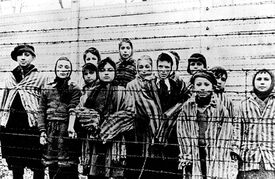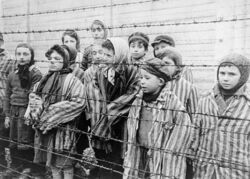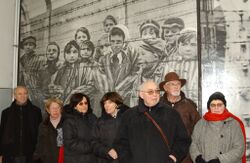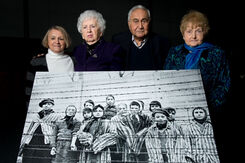Pessa Balter / Paula Lebovics (Poland, 1933)
Pessa Balter / Paula Lebovics (F / Poland, 1933) is a child survivor of the Holocaust.
- <Poland> <Auschwitz> <Mengele Twins> <Liberation of Auschwitz>
Biography
NOTES : Pessa Balter was born in Ostrowiec, Poland in September 1933. She was sent to Auschwitz when she was 10. She survived in the camp among the Mengele Twins until January 27, 1945, when the Red Army arrived. She was reunited with her mother, also an Auschwitz survivor. They both emigrated to the United States in 1952.
Auschwitz Picture
She is present in an iconic Auschwitz picture, that depicts 13 child survivors, shortly after the liberation of the camp. All of them have been identified. From left to right they are:
- (1) Tomy Shacham / Tomy Schwarz (M / Slovakia, 1933)
- (2) Miriam Friedman / Miriam Ziegler (F / Poland, 1933)
- (3) Paula Lebovics / Pessa Balter / (F / Poland, 1933)
- (4) Ruth Muschkies / Ruth Webber (F / Poland, 1935)
- (5) Bracha Katz / Berta Weinhaber (F / Slovakia, 1930)
- (6) Erika Dohan / Erika Winter (F / Czechia, 1931)
- (7) Marta Wise / Marta Slonim (F / Slovakia, 1934)
- (8) Eva Slonim / Eva Weiss (F / Slovakia, 1931)
- (9) Gabor Hirsch (M / Poland, 1929)
- (10) Gabriel Neumann / Gabriel Nejman (M / Czechia, 1937-2012)
- (11) Shmuel Schelach / Robert Schlesinger (M / Czechia, 1934-2006)
- (12 & 13) Eva & Miriam Mozes / Eva Kor (F / Romania, 1934-2019) and Miriam Zieger (F / Romania, 1934-1993).
Paula Lebovics was not among the seven children who reunited on 27 January 2005 in the ceremony in Poland marking 60 years since the liberation of Auschwitz (photograph by Dalit Shacham). The group included (from left to right): Tomy Shacham (1); Erika Dohan (6); Marta Wise (7); Eva Slonim (8); Shmuel Schelach (11); Gabriel Neumann (10); and Bracha Katz (5).
Ten years later, she joined three other survivors who gathered in Krakow, Poland on 26 January 2015, at the invitation of the USF Shoah Foundation, on the eve of the 70th anniversary of the liberation of the death camp. The group included (from left to right): Paula Lebovics (3), Miriam Ziegler (2), Gabor Hirsch (9), and Eva Kor (12). (Photo by Ian Gavan/Getty Images).
USF Shoah Foundation
By the time the Holocaust ended, Paula Lebovics had experienced a ghetto, concentration camp, death camp and the permanent separation of her family – and she was only 12 years old.
Born in Ostrowiec, Poland, on Sept. 25, 1933, Paula was the youngest of six siblings and lived comfortably, surrounded by grandparents, aunts, uncles and cousins. When Paula was just 6 years old, the war began and her family was soon sent to an open ghetto a year later along with the rest of the town’s Jewish population. When one of her brothers learned a year and a half later that there would be a selection to send people to the Ostrowiec forced labor camp, Paula and her parents and siblings hid for several months, desperate to avoid capture.
Paula was briefly separated from the rest of the family while moving between hiding places and discovered by a Ukrainian soldier, who threw her against a wall so hard she was knocked unconscious. After a year and a half in the Ostrowiec forced labor camp, Paula and her family were squeezed onto cattle cars on Aug. 1, 1944, and sent to Auschwitz-Birkenau. Paula remembers sitting on her brother’s shoulders just to be able to get whiffs of fresh air above the adults’ heads in the packed car. She was 10 years old.
At Auschwitz, Paula became a favorite of the guard of her barrack, a young Jewish woman, by singing songs, and sometimes got extra food. Every day she witnessed beatings and killings, until the approaching Soviet Army triggered the Germans to send the majority of camp inmates on death marches to lands that were still under German control. The Soviet Army reached the camp on Jan. 27, 1945, and only the children, elderly and sick were left behind. Just before liberation, the sadistic Dr. Josef Mengele offered to take the children to their families; though Paula refused, she later found the few children who had volunteered shot dead just outside the camp.
After everything she had been through, it’s no surprise that Paula remembers a ragged Soviet soldier crying as he held her in his lap when he found her in the liberated camp. He offered her his own meager rations, and for the first time in a very long time, Paula felt that someone cared about her.
Paula’s mother was liberated in Auschwitz and reunited in Birkenau with Paula, who was now 12. They spent six years at a displaced persons (DP) camp in Germany. Paula’s father and two sisters had been killed, but her three brothers survived and settled in Europe and Israel. When she was 18, Paula and her mother immigrated to Detroit. She met her husband, Michael, also a Holocaust survivor, and they married in 1957. They moved to Los Angeles and had two children, Dan and Linda, where they worked together in Michael’s jewelry business.
Now retired, Paula lives in Encino, Calif., and continues to share her story with students around the world. “Silence is not an option,” Lebovics says. “I want students to learn tolerance, to learn not to bully and not to hate.” She remains in touch with Miriam Ziegler Friedman and Ruth Muschkies Webber, her closest friends in Auschwitz, who appear with her in the photograph. The three are all from Ostrowiec.



